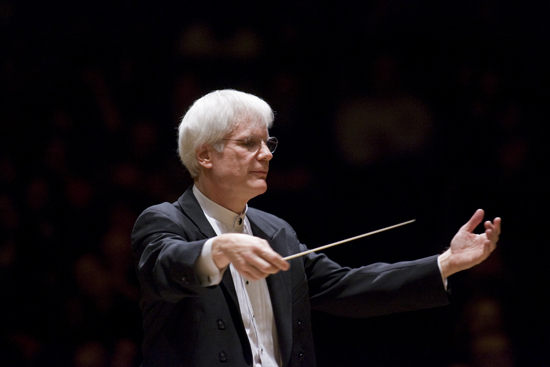Collage program spins off new inspiration from Stravinsky, Schoenberg
Arnold Schoenberg changed the face of classical music in more ways than one. His 12-tone method, of course, stands as his most far-reaching contribution.
But the ensemble he employed for his 1912 work Pierrot lunaire has also taken on a life of its own. Made up of flute, clarinet, violin, cello, piano, and voice the lineup was a pick-up group at the time. Over the past century, however, this Pierrot ensemble his become a staple for composers who continue to push the boundaries of the art form.
Sunday night at Pickman Hall, in a concert presented by Collage New Music, works by five composers made use of variations of this quintet led by David Hoose. Each piece, though, had an identity all its own.
Two of the works heard reflected the influence of another twentieth-century work, Stravinsky’s Rite of Spring.
Much like that 1913 score, Gordon Beeferman’s Rites of Summer is one of stirring drama. The work, composed in 2007 but revised in 2015, opens with gnashing figures that recall the bare repetitions of Stravinsky’s style. A slow section is marked by deep, resonant chords on the piano, which conjure a sense of darkness.
The piece, at its height, glistens with microtonal writing. Stuttering statements in the cello are delightfully pitch-bending, and tingling duets between violin and flute tickle the ear like a feather.
Towards the end of the work, Rites of Summer dissolved into little more than alternating chords between the piano and the rest of the ensemble, as if Beeferman were abstracting Stravinsky into the simplest gestures. The musicians of Collage New Music gave the piece bold advocacy through playing of energy and power.
For Carl Schimmel’s rite. apotheosis, any connection to Stravinsky’s Rite of Spring stops with the title. Schimmel’s piece dates from 2007 and, though it runs to about eight minutes, it is packed with memorable material.
It opens with great stabbing chords that strike the air like lightning. Darting figures erupt only to freeze onto chords of bristly dissonances, as if the music were trying to break free from constraint. It does so mid work, where a yearning violin solo, played with glowing tone by Catherine French, soars above chattering figures in the ensemble. The apotheosis of the work swells into statements of blistering intensity. Romantic sweeps of melody lend a wink of lyricism. The ensemble played it all with energy and commitment.
The oldest work on the program, Seymour Schifrin’s The Nick of Time, reflected the taut musical argument and formal design that marks the best works in contemporary music.
Written in 1978, the last year of Schifrin’s life, The Nick of Time is a journey from darkness to light. The musical language recalls that of Schoenberg, though Schifrin, according to his student Marjorie Merryman, eschewed the 12-tone style for being too prescriptive. Instead, Schifrin’s score unfolds from fragments of melody, though each is imbued with a colorful sense of lyricism.
In the slow movement those figures scatter about the texture with a wide sense of space. They become agitated in the final movement, where they ultimately come together in a powerful chord before shattering once again into fragments.
David Hoose conducted the work with smooth waving gestures that mined the details from every page of Schifrin’s score. The musicians responded with playing of rapt intensity.
The most expressive works on the program featured soprano Janet Brown.
One of Boston’s most beloved singers, Brown possesses a warm, supple voice that brought a sense of vulnerable humanity to works by Daniel Strong Godfrey and Marjorie Merryman.
In Godfrey’s Juliet at Her Window, Brown captured the heart-stirring innocence of Shakespeare’s character. Godfrey’s score, written in 2004 and revised last year, is stunningly beautiful and charmingly lyrical without resorting to romantic cliché. The most affecting song of the set was the third, “My Bounty,” which recalled the opening of Copland’s Appalachian Spring, though in a more disjointed fashion.
Other movements moved as if gentle dances of the heart. “Dost Thou Love Me?” sounded with energy and immediacy, while the final song, “Good Night,” frolicked in its triple meter, like a waltz turning about in space.
Hoose proved a sensitive interpreter of Godfrey’s work, leading the ensemble with grace and finesse.
That same sensitivity marked Sunday’s performance of Marjorie Merryman’s Elegiac Songs. Based on poems by Louise Gluck and completed in 2015 in memory of Merryman’s husband, Edward Cohen, the two songs of this set capture the hopelessness and devastation one feels after the death of a loved one.
Merryman’s music, like Godfrey’s, is an attractive mix of lyrical melody offset by the occasional thorny dissonance. The first song, “The Night Migrations,” unfolds in a dreamy texture. Its final verse pangs with aching sorrow, though the phrases are left to evaporate into silence that offers no remedy for the soul.
“The White Lilies” evokes the sadness of the grave through deep, resonant tones that spread about the ensemble’s texture. Brown, here, delivered her lines with cold radiance. Hoose and the musicians, through playing of quiet presence, captured the poignancy of sorrow. There is much yet to say with tonal music, and Godfrey and Merryman say it well.
The next concert presented by Collage New Music will feature music by Sur, Chasalow, Chen, Child, and Moe 8 p.m. April 2 at Pickman Hall. collagenewmusic.org.
Posted in Performances





